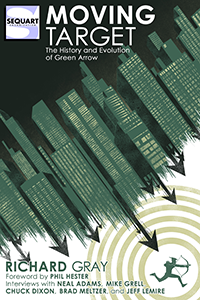Trillium #1
Written by Jeff Lemire
Art by Jeff Lemire
Colors by Jeff Lemire and José Villarrubia
Published by DC/VERTIGO Comics
Rating: 8.5 (of 10)
“Trillium #1 is a captivating and skillful slice of sci-fi adventure, and easily one of VERTIGO’s best debuts.”
Jeff Lemire’s original pitch for his second VERTIGO project was admittedly something similar to what he’d done with Sweet Tooth. His editor Mark Doyle called him out on it. He pushed Lemire to come up with a more unique story and present readers with something they had not seen from him before. Thankfully Doyle challenged him, because the result is Trillium, a sci-fi romance epic that begins with a beautifully-crafted and kinetic first issue.
Trillium #1 brings together two people from completely different eras who are destined to be time-crossed lovers. In a clever, flipbook format with each side ending in the same place and mirroring the other in page count, layout and design, we are introduced to Dr. Nika Temsmith, a strong, female xeniologist from 3797. She desperately pursues a diplomatic solution with an alien race on the distant planet, Atabithi. That world supports Trillium, a flower with unique chemical properties that the scientists of Earthlab 1830-362 need to create a vaccine for The Caul, a virus that has reduced humanity to only 4,000 people.
On the flip side we meet a British, World War I veteran turned explorer named William Price, who is part of a 1921 expedition to discover the “Lost Temple of The Incas” and find a fabled flower that can bring “health and happiness” to those who consume it. William is in a fragile state, terribly scarred by the horrors of war. He hopes the plant’s healing properties can help him battle his inner demons.
Trillium #1 really gives you your money’s worth for $2.99. Along with its interesting premise and symmetrical design, Lemire packs in a lot of exposition and visual information into this issue, vividly defining both worlds and their main characters, especially Nika and her extraterrestrial mission. As she fights to find a way to save humanity, we get some very well-timed snapshots of her relationship with her mother, who also served as an Earthlab Agent. The scenes offer an intriguing portrait of a woman who shared her love for deep space with her daughter, helping her not to be afraid. “It’s okay. We belong to the stars,” Nika’s mother tells her before they plunge into the unknown.
This space exploration tale is something we’ve never seen from Lemire before, as is the visual style he chooses to represent it. Nika’s side of the issue is painted with watercolors, giving it more of an organic, loose feel than the sterile, technological backdrops we typically see in advanced sci-fi. This is easily the best artwork I’ve seen from Lemire. The paints are well suited to his jangly pencils, adding a welcome dose of texture and mood to his line work. Filled with wiry transport vehicles, blue carrot-topped creatures and eerie, alien sandscapes that look like summer homes for the Shai-Hulud, Lemire has imagined a compelling future realm to play in.
Unfortunately the art is less impressive in William’s tale. While Lemire’s character expressions and storytelling are just as good as they are in Nika’s universe, some pages lack the same punch and detail, like the jungle which is often conveyed as a bulbous, beige amoeba. Digitally colored by José Villarrubia, the palette of the 1921 pages echoes the paints of 3797, but at times they feel plain and inconsistent compared to the expressive hues of the future. Some of the scenes, like the bloody flashback to dead soldiers floating in a river, are gorgeously colored. But others, like the double-page spread of natives killing the expedition team, come off flat.
William’s story itself is more grounded than Nika’s. It offers less text but it’s more visceral. Many panels are spent on the wartime experiences that William endured and they are very well done. William’s blank stare in both his present and past are absolutely haunting. I found myself curious to find out more about his time on the battlefield and how he joined the hunt for the temple.
Trillium #1 is a captivating and skillful slice of sci-fi adventure, and easily one of VERTIGO’s best debuts. Although the artwork could be more detailed in some panels, it doesn’t take much away from the overall power of the issue. I absolutely love the parallels Lemire has created between his protagonists – Nika is one of the last humans left in the galaxy, desperately trying to find a way to stop a plague from wiping out our species. William is the last of his platoon, desperately trying to find a way to purge the memories of a war that haunt him. Both are in alien places, hellbent on finding the trillium flower because it represents salvation. I’m on pins and needles waiting to see how this remarkable intersection of two people through time and space spirals into “the LAST love story ever told.”























































